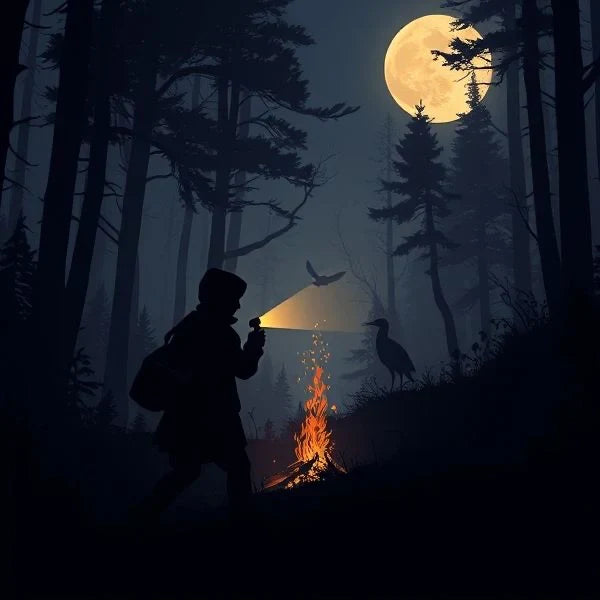Introduction

What Is Snipe Hunting?
Snipe hunting usually starts with a flashlight, a bag, and an optimistic camper at the edge of the woods. Maybe it is your first night at summer camp or your first weekend on a Scout trip. An older camper grins, hands you a bag, and explains that there is something called a snipe. “It’s shy,” he says. “It only comes out after dark. We’ll hunt it your way.” You stand waiting, bag in hand, heart pounding.
Ten minutes pass. Then twenty. No snipe. No sounds. No one returns. That is when it hits you: the hunt was a joke.
The instructions for the prank can vary: some may involve tapping rocks, whispering, or saying nothing; however, the result is always the same. The "hunter" is left alone, bag in hand, while the others sneak away into the night.
The snipe hunt is uniquely tied to an outdoor setting. It blends just enough realism by using a real animal's name with total fabrication. It's not just about tricking someone. When done, it becomes a rite of passage. Yes, you’ve been tricked, but you’ve also been initiated and are part of the group.

Image source: The Legend of Snipe Hunting
How Snipe Hunting Began and Spread
Cultural Origins of Snipe Hunting
The snipe hunting did not spring out of nowhere; it has roots in 19th-century North America. It also draws directly from older European traditions of sending novices on "fool's errands." These make-believe missions are designed to taunt, test, and finally initiate participants.
In Britain, a junior would be dispatched to fetch "tartan paint" or a "bucket of steam." In France, children were told to catch the dahut, a mountain animal has a shorter leg on one side, which supposedly allows it to run in a circle. In Spain, it's the gamusino, an animal so vague it doesn't even have a defined shape or behavior. In each case, the goal is the same: to create shared laughter within the group.
By the early 20th century, the joke had become a mainstay of American summer camps and scouting tradition. What helped it catch on was the ingenious use of a real name, "snipe." In contrast to the fantastical beasts in other nations, the snipe gave the joke just enough believability to succeed. Children didn't doubt it; after all, it did sound like a bird.

Image source: The Legend of Snipe Hunting
Modern Variations in American Camps
Part of the magic lies in how the story differs from camp to camp. At one camp, the snipe is described as a bird-rabbit hybrid covered in fuzz. At another camp, it has a phosphorescent glow or makes a deer-like sound. Some claim it can only be caught during a full moon. Others insist special bait is required, such as bog leaves, marshmallows, or even sticks covered with honey. Entire rituals develop around the hunt, including mock calls, snipe songs, and whispered instructions passed along by seasoned campers.
Sometimes, the joke ends in a spectacle. The camper returns with the bag, claiming success, only to have it run out as soon as it's unzipped. Other times, the victim is left alone for so long that they begin to question what's real. The tradition's flexibility is part of its survival. It adapts to new generations, new settings, and even new technologies.

Image source: @Enjoy The Life on YouTube
Snipe Hunting Changing with the Times
A Kinder Hunting Game
While the snipe hunt originated as an innocent prank, today, it has a thoughtful perspective. As awareness of emotional well-being and environmental responsibility grows, most outdoor programs are questioning how this tradition should continue. A prank that's meant to be funny can take a negative turn if a kid is left alone for too long. In severe situations, it can resemble hazing. To preserve the friendship without cruelty, modern camps nowadays alter the ritual. Some make it an interactive game with storytelling, comedic clues, or nature riddles.

Snipe Hunting in Pop Culture and Media
The concept of the snipe hunt didn't stay at camp. Over the years, it quietly slipped into pop culture. You'll find it in movies, TV shows, games, and even internet trends. Each version shares the same idea: someone's chasing something that isn't real, or at least, not in the way they think.
In the Pixar film Up, Russell is sent to find a snipe. Instead, he finds a giant bird named Kevin. Sitcoms like Boy Meets World, King of the Hill, and The Simpsons all use snipe hunts or other such "fool's errands." These moments serve as a tool for mocking gullibility or group ritual.

Carl facing the bird Kevin
Image source: Screenshot from the film Up (Pete Docter, 2009)
Even in today's outdoor culture, the prank hasn't lost its pull. Variations now include digital twists such as "snipe hunts" that incorporate geocaching, QR-code clues, or app-based treasure trails. Additionally, since real snipes are so elusive, some campers, hikers, or even amateur biologists use the phrase semi-seriously when trying to spot one in the wild.
Additionally, RPGs and fantasy games often include "snipe-hunts" as well. These quests are effectively pointless tasks, but they pay homage to old players familiar with the trope. Even on the internet, the nature of the prank remains. TikTok trends like "invisible pranks" or "fake fetch" replicate the same rhythm: set up, chase, reveal.

Image source: Steam
Snipe in Reality: from Campfire to Conservation
The snipe hunt may be imaginary, but the bird behind the name is very real. So what do we know about actual snipes? According to Wikipedia, a snipe is one of about 26 species of wading birds in the family Scolopacidae. They have long, slender bills, high-set eyes, and cryptic, camouflaged plumage.
While stories of the snipe hunt thrive, the real snipes face far less amusing challenges. Wilson's Snipe and its kin rely on delicate wetland habitats, mudflats, bogs, and damp meadows, which are rapidly disappearing. Some species, like the Chatham Island Snipe, are in danger of habitat loss and invasive predators. In the U.S. Rainwater Basin, areas that were once filled with birds are now too dry during spring migration. Urbanization, agricultural drainage, and droughts driven by global warming are shrinking their breeding and feeding grounds.

Snipe
Luckily, the shift from prank to conservation is gaining traction. Conservation organizations like BirdLife International and Wetlands International are pushing for greater protection of migratory routes and breeding grounds. The Ramsar Convention already protects over 2,000 internationally significant wetlands. In the United States, local partnerships and organizations like Ducks Unlimited augment vital restoration efforts.
Conclusion
The snipe hunt continues to live because it does more than a fool; it creates a bond. It turns a harmless joke into a shared story. What starts with a flashlight and a sack becomes a rite of passage and a lesson. When you eventually discover the bird is real, the punchline resonates on a deeper level. Because sometimes, chasing the impossible brings you closer to reality. That's why we keep telling the story, not for the deception but for the journey it leads us on.
If you’re fascinated by elusive birds like the snipe, don’t miss our in-depth article on the mysterious potoo—another master of camouflage hiding in plain sight.

FAQs About Snipe Hunting
Is snipe hunting real or fake?
The prank itself is fake; you're not meant to catch anything. However, the bird behind is entirely real. Snipe are tricky wetland birds with great camouflage and an erratic flight style. That's what makes the joke so clever: it's based on something just believable enough to catch people off guard.
What does an actual snipe look like?
Snipes are small, streaky birds that are great for hiding. Snipes possess long bills, brown feathers, and the ability to blend in with muddy ground.
Can snipe hunting be educational?
Yes. Some nature programs use pranks such as "snipe hunts" to teach kids about wetland birds and their environments. A prank can spark interest in birdwatching, ecology, and conservation. It's a great way to turn curiosity into connection.
Is it okay to pull a snipe hunting prank on someone?
It's okay if it is executed correctly. If everyone ends up laughing and no one feels excluded, it can become a wonderful group memory. However, if someone feels frightened, embarrassed, or left behind, then it's no longer funny. The best snipe hunts draw people rather than push them away.




Leave a comment
All comments are moderated before being published.
This site is protected by hCaptcha and the hCaptcha Privacy Policy and Terms of Service apply.